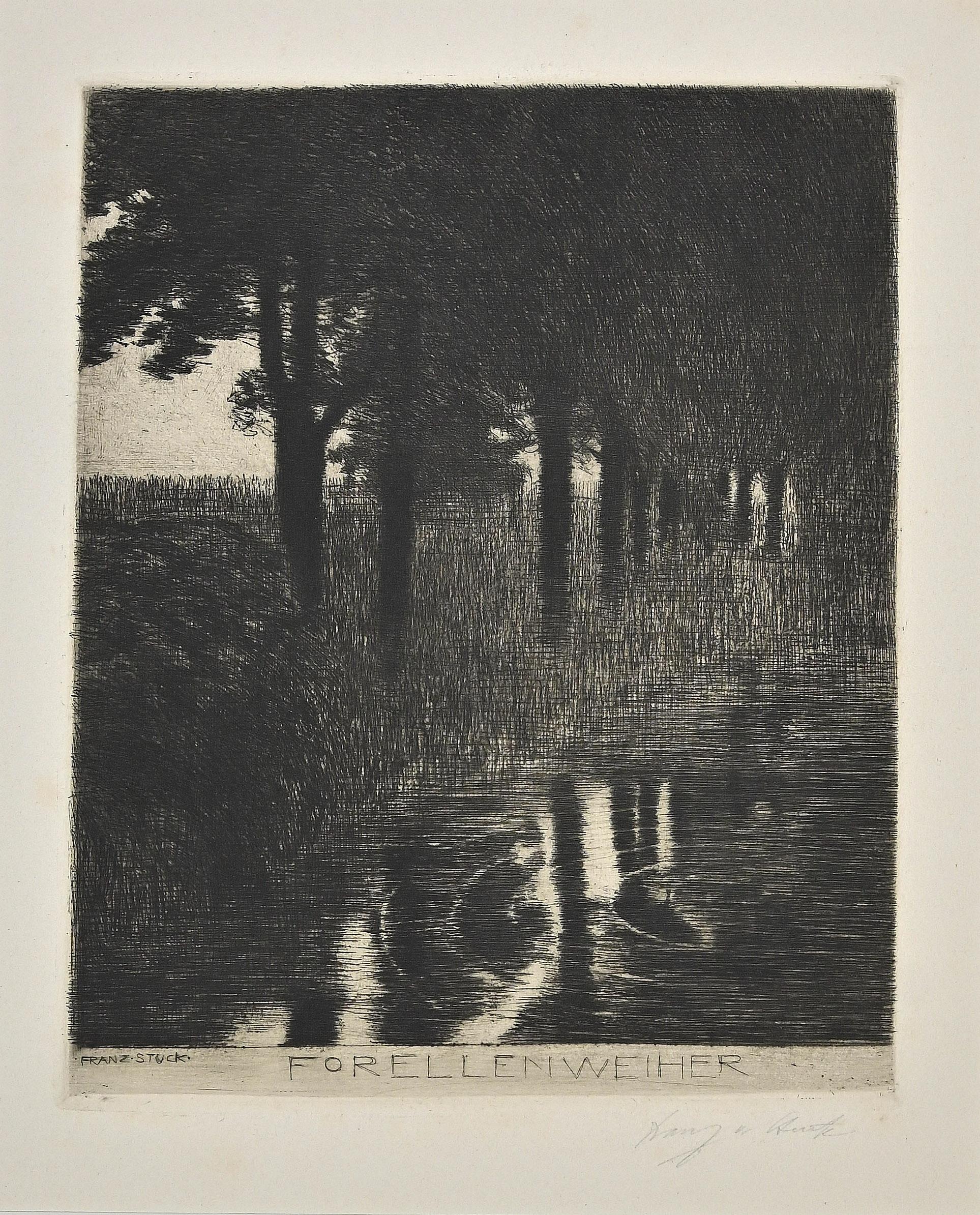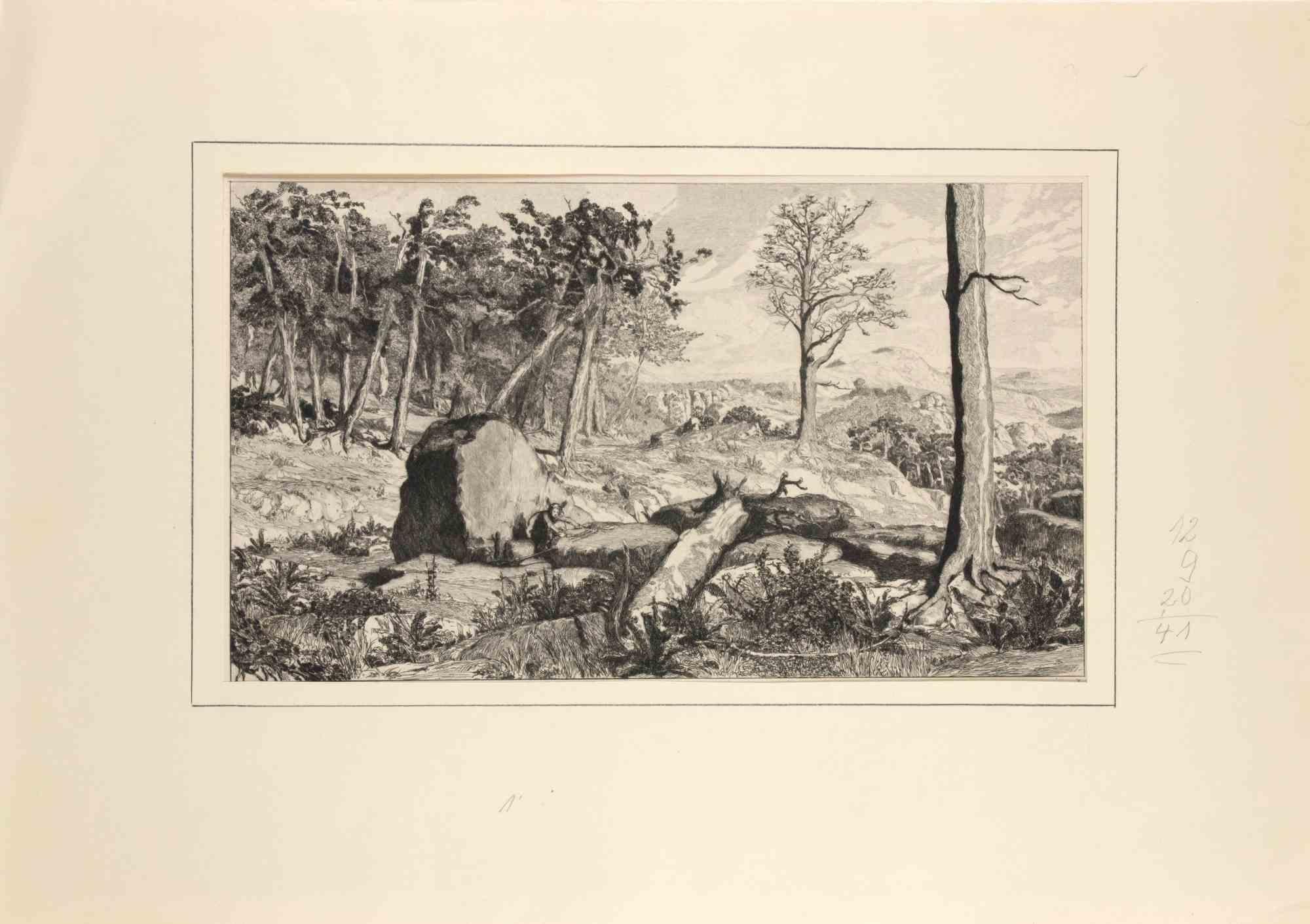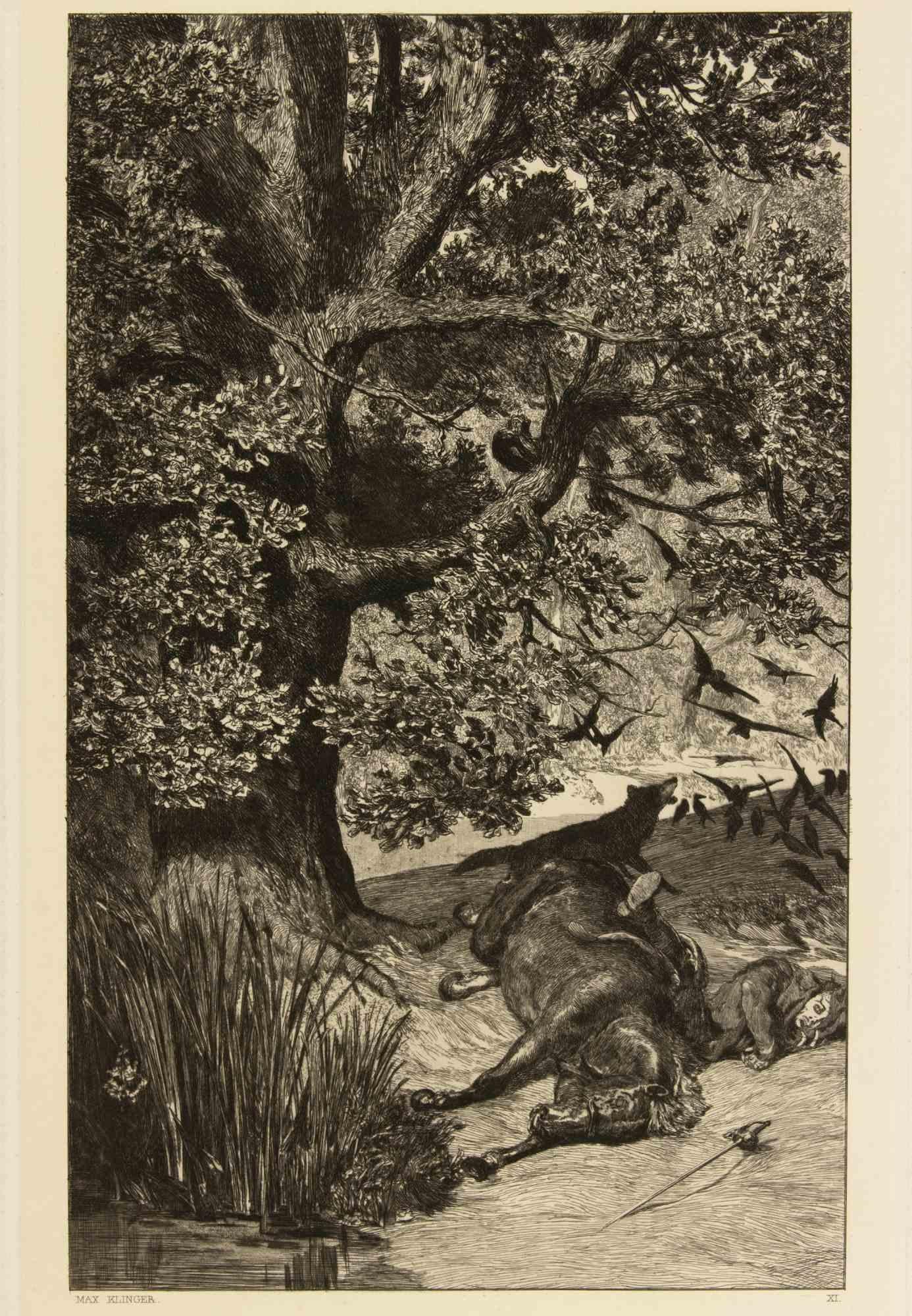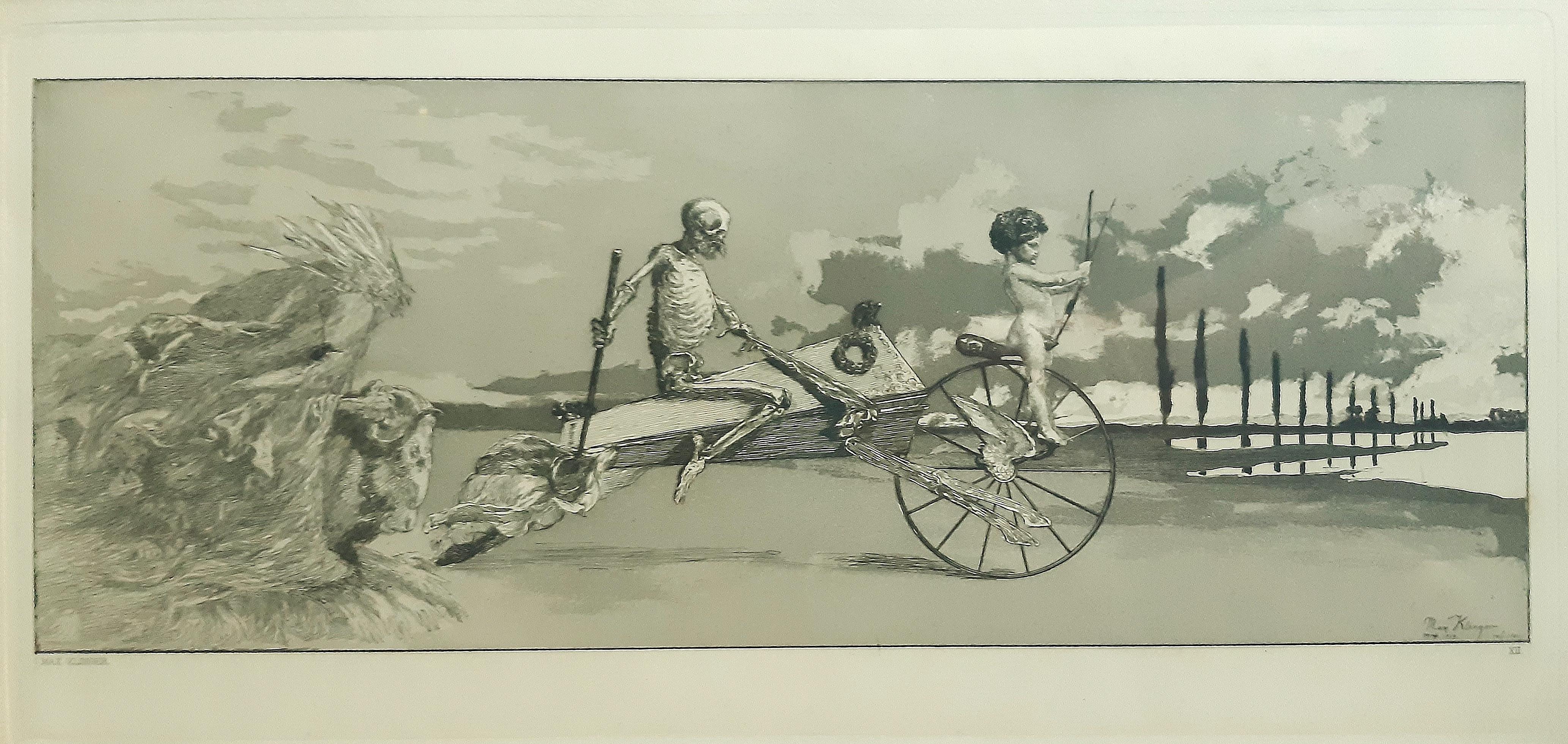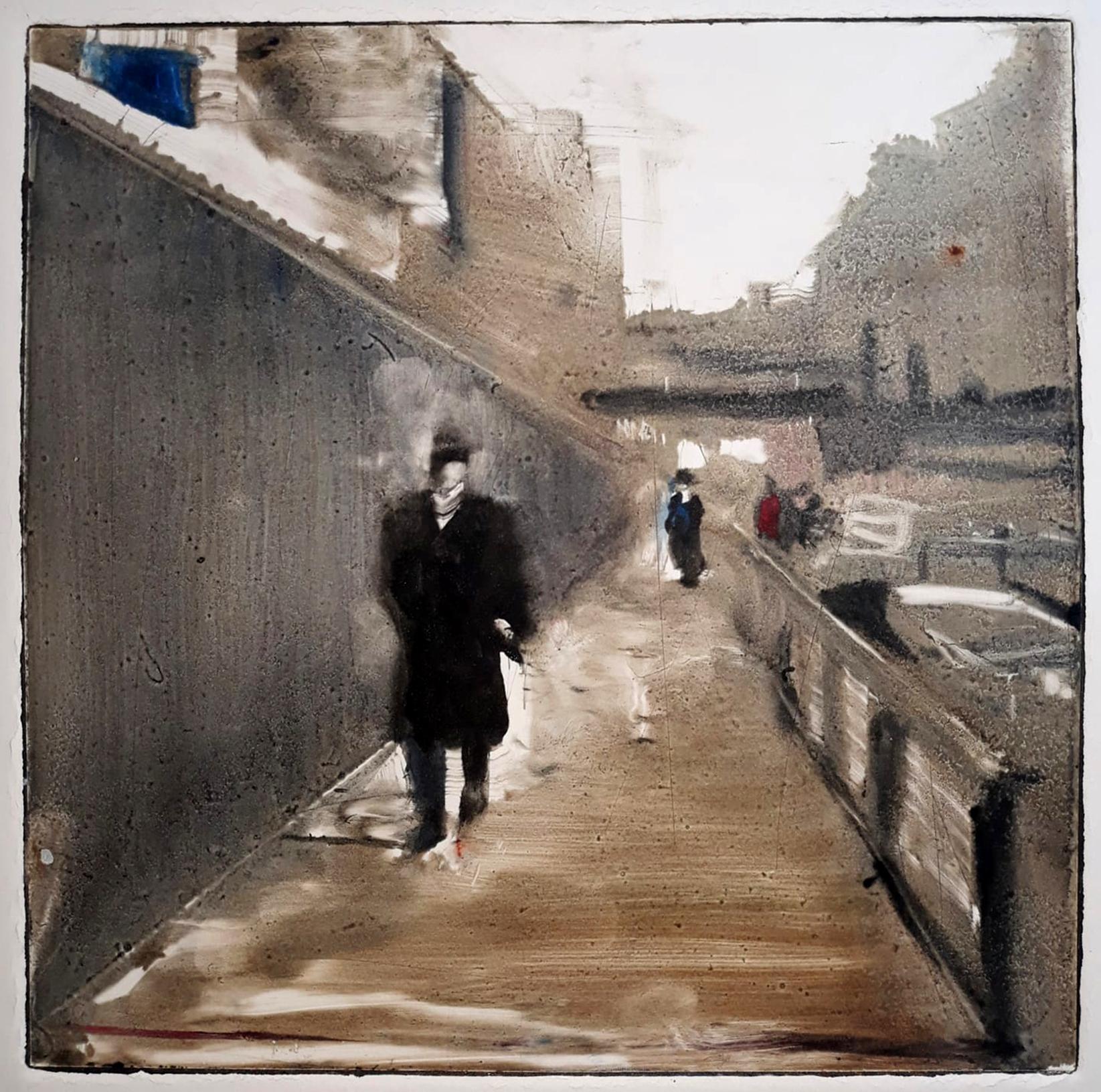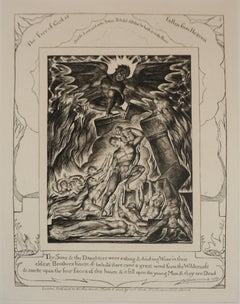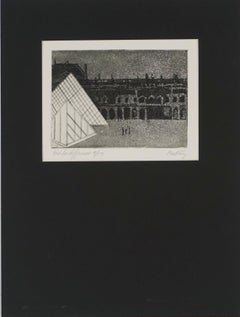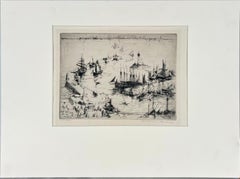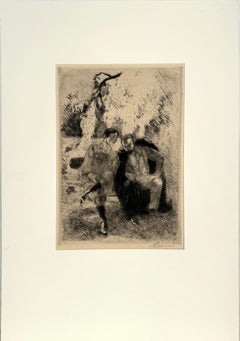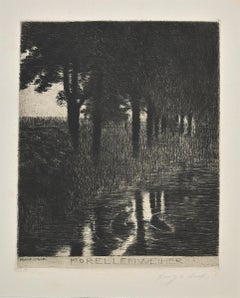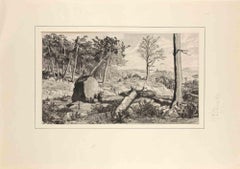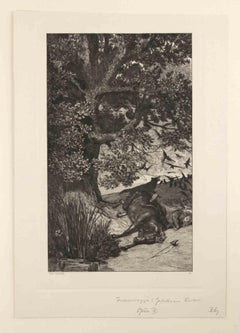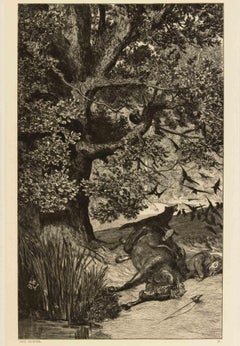Articoli simili a "The Graces Lie Shy" Intaglio Etching
Vuoi altre immagini o video?
Richiedi altre immagini o video al venditore
1 di 13
Chaim Koppelman"The Graces Lie Shy" Intaglio Etching1958
1958
Informazioni sull’articolo
"The Graces Lie Shy" intaglio etching by Chaim Koppelman (American b.1920 d.2009).
Moody etching by prominent American printmaker and educator Chaim Koppelman. In this piece a nude female figure is laying in a patch of grass at the bottom right corner, she is ringed in by a row of rocks, behind which a man with a large coat and hat stands. Bare tree branches stretch into a dim and textured cloudy sky on either side of them. Both of the figures subtly interact with the background. The lines shaping the woman's body blend in with the grass and the texture of the clouds is visible through the semi-transparent figure of the man. The title of the piece is taken from a poem by Eli Siegel, a friend and mentor of Koppelman; "Even in our dooms/ the graces lie, shy and unperturbed."
The phrase implies that even in difficult situations, a quiet presence of good or divine favor remains undisturbed. This grace may not be immediately apparent, but it is subtle and unwavering. This suggests a theme of finding hope and resilience amidst suffering.
This phrase is reminiscent of a quote by Aeschylus, which speaks of how wisdom can come through suffering. Difficult experiences can lead to a deeper understanding and appreciation for life's graces
Mat size: 24" H x 24" W
Image size: 16" H x 18.75" W
Paper is cut unevenly and measures 19" H x 22.5" W at its widest points.
Numbered and title in bottom left "Ed. 25 The Graces Lie Shy"
Signed in bottom right corner "Chaim Koppelman '58."
Chaim Koppelman (1920–2009) was a distinguished American artist, printmaker, and educator who played a key role in shaping modern printmaking. Renowned for his mastery of etching and aquatint, his work was marked by a bold fusion of classical precision and imaginative freedom. He was deeply influenced by Aesthetic Realism—the philosophy founded by Eli Siegel, which posits that all beauty is a “oneness of opposites.” Koppelman established the Printmaking Department at the School of Visual Arts in 1959 and taught there for nearly five decades. His art, infused with ethical inquiry and psychological insight, was widely exhibited and is represented in major institutions including MoMA, the Whitney, the National Gallery, and the Victoria and Albert Museum. He was a lifelong advocate for Aesthetic Realism, integrating its principles into both his creative process and teaching.
Koppelman’s early training included study under artists such as Will Barnet and Jose de Creeft, and he was active in New York’s vibrant postwar art scene, working with Atelier 17 and the Robert Blackburn Printmaking Workshop. With his wife Dorothy, he co-founded the Terrain Gallery, which became a hub for artists exploring Siegel’s ideas. His work often grappled with social justice and personal conflict, seen in allegorical prints that addressed war, identity, and moral struggle.
- Creatore:Chaim Koppelman (1920 - 2009, Americano)
- Anno di creazione:1958
- Dimensioni:Altezza: 60,96 cm (24 in)Larghezza: 60,96 cm (24 in)Profondità: 6,35 mm (0,25 in)
- Tecnica:
- Movimento e stile:
- Periodo:
- Condizioni:Paper is cut unevenly. Some small tears around the edges which have been stabilized with archival tape. Light discoloration and bending on paper consistent with age. Mat is new.
- Località della galleria:Soquel, CA
- Numero di riferimento:Venditore: JMA 98681stDibs: LU54216433152
Informazioni sul venditore
5,0
Venditore Platino
Venditori Premium con valutazione 4.7+ e tempi di risposta entro 24 ore
Fondazione nel 1986
Venditore 1stDibs dal 2014
2.918 vendite su 1stDibs
Tempo di risposta standard: <1 ora
- SpedizioneRecupero del preventivo…Spedizione da: Soquel, CA
- Politica di reso
Alcune parti di questa pagina sono state tradotte automaticamente. 1stDibs non può garantire che le traduzioni siano corrette. L’inglese è la lingua predefinita del sito.
Garanzia di autenticità
Nell’improbabile caso in cui si verifichi un problema con l’autenticità di un articolo, contattaci entro un anno per ottenere un rimborso completo. DettagliGaranzia di rimborso
Se il tuo articolo non corrisponde alla descrizione, è danneggiato durante il trasporto o non arriva, contattaci entro 7 giorni per un rimborso completo. DettagliAnnullamento entro 24 ore
Hai un periodo di tolleranza di 24 ore per annullare il tuo acquisto, senza necessità di fornire spiegazioni.Venditori professionali selezionati
I nostri venditori di livello internazionale devono aderire a rigorosi standard di servizio e qualità, garantendo l’integrità delle inserzioni.Garanzia miglior prezzo
Se scopri che un venditore ha pubblicato altrove lo stesso articolo a un prezzo più basso, applicheremo lo stesso prezzo.Consegna globale affidabile
La nostra rete di vettori leader del settore offre opzioni di spedizione specializzate in tutto il mondo, inclusa la consegna personalizzata.Altro da questo venditore
Mostra tuttoIllustrazioni del Libro di Giobbe - "Il fuoco di Dio è caduto dal cielo
Di William Blake
"Illustrazioni del Libro di Giobbe" Incisione "Il fuoco di Dio è caduto dal cielo... E il Signore disse a Satana: "Ecco, tutto quello che ha è in tuo potere"".
Incisione, terza stam...
Categoria
Anni 1870, Simbolismo, Stampe figurative
Materiali
Carta fatta a mano, Incisione
Litografia astratta del Museo Louve con le Piramidi di E. A. M. Pei
Di Bu King
Litografia astratta di Louve con E. A. M. Piramidi di vetro Pei
Litografia in edizione limitata di un paesaggio urbano astratto, con campi di colore giallo e verde fratturati, di Bu...
Categoria
Fine XX secolo, Cubismo analitico, Stampe (paesaggio)
Materiali
Carta, Inchiostro, Acquatinta, Litografia
"Snug Harbor" Acquaforte di una romantica scena portuale 1928
Di Armin Hansen
"Snug Harbor" Acquaforte di una romantica scena portuale 1928
Navi alte in un "porto tranquillo" di Armin Hansen (americano, 1886-1957). Su carta ondulata.
Immagine, 6" H. x 8" L.
F...
Categoria
Anni 1920, Impressionismo americano, Stampe (paesaggio)
Materiali
Carta vergata, Acquaforte
"Confidenze" James Abbott McNeill Whistler Conversazione con un collega artista
Di Paul Albert BESNARD
"Confidenze" James Abbott McNeill Whistler Conversazione con un collega artista
"Confidenze" James Abbott McNeill Whistler Conversazione con un collega artista
Acquaforte a puntasecc...
Categoria
Inizio Novecento, Impressionismo, Stampe figurative
Materiali
Carta fatta a mano, Puntasecca, Acquaforte
1.240 USD Prezzo promozionale
20% in meno
Il corteggiamento di Washington - Acquaforte su carta del 1932
Di William Auerbach-Levy
Il corteggiamento di Washington - Acquaforte su carta del 1932
Incisione in bianco e nero del 1932 raffigurante George e Martha Washington di William Auerbach-Levy (russo, 1889-1964...
Categoria
Anni 1930, Impressionismo americano, Stampe figurative
Materiali
Carta vergata, Acquaforte
"Un Grain à Trouville" (Una tempesta a Trouville) da L'Illustration Nouvelle
Di Félix Hilaire Buhot
"Un Grain à Trouville" (Una tempesta a Trouville) da L'Illustration Nouvelle
Drammatica incisione di una tempesta in arrivo di Félix Hilaire Buhot (francese, 1847-1898). Le persone ...
Categoria
Anni 1870, Scuola di Barbizon, Stampe (paesaggio)
Materiali
Carta vergata, Acquaforte, Acquatinta
Ti potrebbe interessare anche
Forellenweiher - Acquaforte e puntasecca di Franz von Stuck - 1890
Di Franz von Stuck
Forellenweiher è una meravigliosa acquaforte e puntasecca in bianco e nero su carta crema a canne larghe realizzata da Franz von Stuck nel 1890-1891.
Fir...
Categoria
Anni 1890, Simbolismo, Stampe figurative
Materiali
Carta, Puntasecca, Acquaforte
Opus IV, Simplicius in der Waldeinode - Acquaforte di Max Klinger - 1881
Di Max Klinger
L'opera IV, Simplicius in der Waldeinode (Simplicio nel deserto) appartiene a una serie di stampe chiamate Intermezzi realizzate da Max Klinger, pubblicate da Nurnberg: Stroefer, 188...
Categoria
Anni 1880, Simbolismo, Stampe figurative
Materiali
Acquaforte
Cavaliere caduto - Acquaforte di Max Klinger - 1881
Di Max Klinger
Fallen Rider è un'opera d'arte moderna realizzata da Max Klinger nel 1881.
L'opera appartiene a una serie di stampe chiamate Intermezzi realizzate da Max Klinger, pubblicate da Nurn...
Categoria
Anni 1880, Simbolismo, Stampe figurative
Materiali
Acquaforte
Cavaliere caduto - Acquaforte di Max Klinger - 1881
Di Max Klinger
Fallen Rider è un'opera d'arte moderna realizzata da Max Klinger nel 1881.
L'opera appartiene a una serie di stampe chiamate Intermezzi realizzate da Max Klinger, pubblicate da Nurn...
Categoria
Anni 1880, Simbolismo, Stampe figurative
Materiali
Acquaforte
Amor, Tod und Jenseits - Acquaforte di M. Klinger - 1881
Di Max Klinger
Amor, Tod und Jenseits, (Cupido, morte e aldilà) è un'acquaforte e acquatinta originale su carta Chine collé, realizzata da Max Klinger nel 1881, tavola XII da "Intermezzi" Opus IV...
Categoria
Anni 1880, Simbolismo, Stampe figurative
Materiali
Acquaforte, Acquatinta
1.306 USD Prezzo promozionale
30% in meno
Ghosts of New York 2, paesaggio urbano drammatico monocromatico dalle sfumature surreali
Di Tom Bennett
Uno di una serie di monotipi a base di olio su carta da stampa pregiata. Monocromatico con colori tenui. Immagine umorale, simbolista/espressionista che riflette sull'ambiente attual...
Categoria
Anni 2010, Simbolismo, Stampe (paesaggio)
Materiali
Monotipo, Carta per archivio
